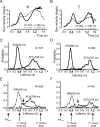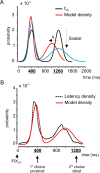How do primates anticipate uncertain future events?
- PMID: 17442817
- PMCID: PMC6672312
- DOI: 10.1523/JNEUROSCI.0388-07.2007
How do primates anticipate uncertain future events?
Abstract
The timing of an upcoming event depends on two factors: its temporal position, proximal or distal with respect to the present moment, and the unavoidable stochastic variability around this temporal position. We searched for a general mechanism that could describe how these two factors influence the anticipation of an upcoming event in an oculomotor task. Monkeys were trained to pursue a moving target with their eyes. During a delay period inserted before target motion onset, anticipatory pursuit responses were frequently observed. We found that anticipatory movements were altered by the temporal position of the target. Increasing the timing uncertainty associated with the stimulus resulted in an increase in the width of the latency distribution of anticipatory pursuit. These results show that monkeys relied on an estimation of the changing probability of target motion onset as time elapsed during the delay to decide when to initiate an anticipatory smooth eye movement.
Figures







References
-
- Barlow RE, Marshall AW, Proschan F. Properties of probability distributions with monotone hazard rate. Ann Math Stat. 1966;37:1574–1592.
-
- Barnes GR, Donelan SF. The remembered pursuit task: evidence for segregation of timing and velocity storage in predictive oculomotor control. Exp Brain Res. 1999;129:57–67. - PubMed
-
- Blohm G, Missal M, Lefèvre P. Smooth anticipatory eye movements alter the memorized position of flashed targets. J Vis. 2003;3:761–770. - PubMed
Publication types
MeSH terms
LinkOut - more resources
Full Text Sources
